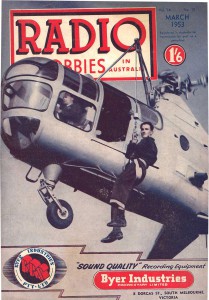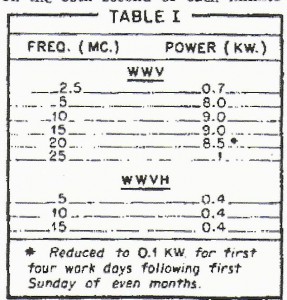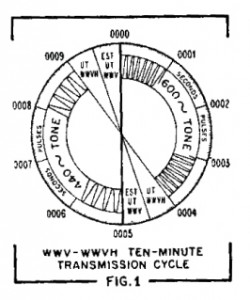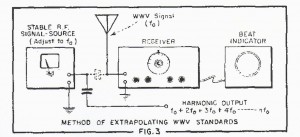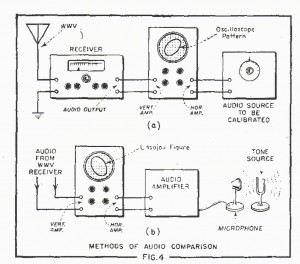Using Standard Signals From WWV
Possibly not all readers realise that very precise standards of time and frequency are available on the short-wave bands to anyone possessing a suitable receiver. This paper, prepared by engineers of the Aerovox Corporation, summarises the present transmissions and suggests methods by which the information can be used.
THE standard time and frequency transmissions of the National Bureau of Standards radio stations WWV and WWVH provide an invaluable service to laboratories and individual experimenters throughout the world.
Extremely precise audio and radio frequency standards, as well as accurate time intervals and radio frequency propagation warnings, are placed at the disposal of anyone having a receiver capable of tuning to one or more of the transmitting frequencies.
TRANSMISSION SCHEDULES
The proper use of these facilities can be made to greatly supplement the instrumentation of any laboratory. However, the maximum utilisation of this valuable “natural resource” depends upon a knowledge of the broadcasting schedules, transmitting frequencies, and suitable methods of comparison.
The standard frequency stations WWV and WWVH are operated by the Central Radio Propagation Laboratory of the National Bureau of Standards. Station WWV is located at Bellsville, Md, (near Washington. DC). and WWVH is on the island of Maui, Hawaiian Islands.
Both stations broadcast continuously on the carrier frequencies and with the output powers shown in Table 1. This diversity of geographical location and transmitting frequencies places the services of these stations on an essentially world-wide coverage basis.
The standard carrier frequency transmissions of WWV and WWVH are modulated with various standard audio tones and time interval signals in order to provide calibration information for a wide variety of instruments.
STANDARD AUDIO
During the first four minutes of each five minute interval, starting on the hour, the carriers are modulated by accurate sinusoidal time signals; 600 cycles per second is used during the first four minute period, followed by 440 cycles during the second period, &c. These two audio frequencies are alternated each five minutes throughout the hour.
At the beginning of the fifth minute of each five minute interval, the tone modulation is interrupted for exactly one minute during which station identification is given in voice from WWV and in International Morse Code from WWVH.
Also during this minute, Eastern Standard Tune is announced from WWV in voice, and Universal Time is sent in code from both stations.
During the entire transmission, a five-millisecond (.005 second) pulse signal is superimposed upon the carrier. This pulse consists of five cycles of a one kilocycle sine wave and is heard as a sharp “tick” which accurately marks the passage of each second.
This “seconds pulse” is omitted on the 59th second of each minute to accurately identify one minute intervals. Figure 1 illustrates the transmitting cycle of WWV, which is repeated every 10 minutes, starting on the hour.
In addition to the standard time and frequency transmissions, WWV also broadcasts radio propagation disturbance warning notices for the benefit of commercial services and amateurs whose communications depend upon conditions in the ionosphere. These announcements are made In code during the 19th and 49th minute of each hour.
As of July 1, 1952, the system was revised to include not only the transmission of a symbol to indicate the present ionospheric conditions affecting communication paths over the North Atlantic, but also a numeral to indicate the condition forecast for the next 12 hours.
CONDITIONS
Thus, the letters “N,” “U,” or “W,” sent five times in code, mean that the present radio reception conditions are “normal,” “unsettled,” or “disturbed,” respectively, while a numeral which follows each letter indicates that the forecast for the next 12 hours is for conditions to continue as follows:
Forecast
Numeral Propagation Condition
1. Impossible,
2. Very poor,
3 Poor,
4 Fair to Poor,
5, Fair,
6. Fair to Good,
7. Good,
8. Very good,
9. Excellent.
According to this system, the characters “W7” transmitted from WWV would be interpreted to mean that the present ionospheric conditions affecting radio propagation were “disturbed,” but expected to improve to “good” within the next 12 hours.
The accuracies of the audio and radio frequencies and other information broadcast by stations WWV
and WWVH are a great as the present state of the engineering art will permit. All frequencies transmitted from both stations are accurate to within two parts in 100 – million.
A discussion of the means employed to insure this precision is of general interest and aids in gaining an appreciation of the meticulous care required to maintain the national primary frequency standard.
The carrier frequencies at WWV are derived from the average of eight precision quartz crystal oscillators which are operated continuously. These oscillators all operate on 100 kilocycles per second from battery power and are housed in subterranean vaults 25ft below the earth’s surface.
The temperature and humidity of these vaults are very carefully controlled to insure maximum frequency stability.
The frequencies of the oscillators are compared continually among themselves and are checked against the basic frequency standard — the period of the earth’s rotation.
CONTROL SYSTEM
The “control standard” oscillator which is chosen to control WWV drives a chain of frequency dividers and multipliers which convert the fundamental 100 kc. frequency to a wide variety of standards ranging from one cps. to 30,000 mc.
All radio and audio frequencies broadcast are thus derived from one oscillator and are therefore of comparable accuracy.
The 60 cycle standard is used to drive a synchronous clock motor which allows the standard to be checked against Naval Observatory time. In this manner, the time signals as broadcast from WWV agree with Naval Observatory time to within several hundredths of a second and have a diurnal variation which never exceeds 2-millionths seconds.
The frequency standards at WWVH are similar to those used at WWV and are maintained in agreement with WWV signals to within two parts in 100—million by comparison. These comparisons are made during the four minutes following each hour and half-hour when WWVH Is off the air and during 34 minute interruptions which occur at 1900 hours GMT.
From most points in the continental United States, the standard frequency broadcasts of WWV can be received on a relatively simple receiver. One of the superheterodyne type having good selectivity and automatic volume control is to be preferred, however. These features are usually found in communications-type receivers.
Under normal propagation conditions, such receivers are capable of receiving WWV or WWVH transmissions on several of the standard frequencies, thus permitting good flexibility of measurement.
The simplest and most direct way of utilising standard frequency transmissions is the use of the
transmitted signals as check points to calibrate the dial of a receiver. The variety of transmitted frequencies usually insures that one WWV signal falls within each tuning range of multi-band receivers.
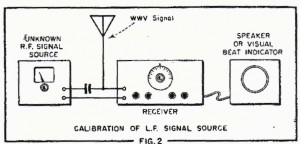
DIAL CALIBRATION
The accuracy of the receiver dial calibration my then be checked against the standard frequency carrier and any serious deviation corrected by adjusting either the receiver dial mechanically, or the receiver local oscillator trimmer.
In all cases the receiver should be allowed to reach thermal equilibrium before comparisons are made.
Figure 2 illustrates a method a comparing the frequency of tuneable signal sources such as signal generators, grid-dip meters, and amateur VFO’s with the WWV standard. The method is also applicable to fixed frequency standard oscillators which operate close to some sub-multiple of a WWV carrier frequency.
The signal source to be calibrated is loosely coupled by radiation or capacity coupling to the WWV receiver, which is carefully tuned to an appropriate WWV signal. The frequency of the signal source is then varied until a beat note between one of its harmonics and the WWV carrier is heard in the receiver output.
When the local signal is adjusted to produce zero beat, its frequency is exactly equal to that of WWV or is an exact sub-multiple of it.
If the device being checked has an approximate calibration, the order of the harmonic is easily identified. Otherwise, the fundamental frequency of the unknown source can be found by determining the frequency difference between two adjacent harmonics on the receiver.
BEAT NOTES
Thus, a one megacycle signal will produce a beat with the five megacycle carrier of WWV and will also be heard at four and six megacycles on the communication receiver, while a 5 megacycle signal will beat with the five megacycle carrier and will also be heard at 4.5 and 5.5 megacycles. This makes it possible to obtain many check points which will be highly accurate as long as the integral multiple is maintained at zero beat with WWV.
A visual beat indicator, such as an audio output meter across the receiver output, is usually more accurate than the aural method.
When it is necessary to provide standard check points at frequencies considerably higher than the highest available WWV carrier, the arrangement shown in Fig. 3 is employed. In this method. a tuneable HF oscillator of suitable frequency stability is zero beat in a receiver with the WWV standard.
The harmonics of this oscillator will then appear at precisely integral multiples of the standard frequency to which it is referred.
If the auxiliary oscillator has sufficient power output, these harmonics will extend quite high in frequency and may be used as ”markers” throughout the VHF and lower UHF regions. In one method crystal oscillator of conventional design is adjusted to operate at zero beat with WWV and supplied with unfiltered DC to enhance the harmonic content. A secondary standard of some type will usually be required to identify harmonics.
Electronic audio equipment, as well as musical instruments capable of sustained tones, may be referred to the 440 and 600 cycle tones broadcast by WWV or WWVH by means of the layouts illustrated in Fig. 4. For audio oscillators and other equipment having an electrical output signal, Fig. 4a is employed.
CONNECTIONS
The output of the WWV receiver (tone control and beat frequency oscillator off) is coupled to the amplifier feeding one set of plates of an oscilloscope, while the output of the device, being calibrated is coupled to the amplifier feeding the other set of deflection plates. When the frequency of the local source is adjusted to equal the audio tone being transmitted by WWV, a stationary circle or ellipse will appear on the cathode ray tube.
Other integral multiples or sub-multiples may easily be identified by means of the Lissajou figure produced. A description of the use of Lissajou Patterns may be found in any engineering text.
To calibrate the musical pitch produced by non-electronic sources, the equipment shown in Fig 4b is required. Since the source does not produce an electrical audio output, a microphone and suitable audio amplifier must be used to convert the audio output of the device into an electrical signal for comparison with that received from WWV.
As in Fig. 4a. the frequency of the unknown source is identified by the oscilloscope pattern produced.
Comment on Using Standard Signals From WWV, from Bill Marsh:

